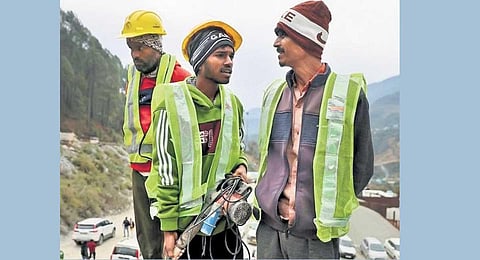

BHUBANESWAR: The 17 days of entrapment in the collapsed Silkyara tunnel at Uttarakhand’s Uttarkashi district were the longest in the lives of Dhiren Nayak, Bisweswar Nayak, Raju Nayak, Bhagaban Bhotra and Tapan Mandal, all from Odisha. After living amidst hope and despair for over 400 hours, the migrant labourers have stepped into a new life.
The first 24 hours, they admit, were the most difficult. To ensure there is oxygen flow into the tunnel, the workers had removed two 6-inch water pipes from the area (2.5 km) of entrapment and used them to send signals to people outside the tunnel.
“There were some engineers outside who realised there are people trapped inside the tunnel. Seven hours later, rescuers established contact with us through the same pipe and sent us dry food,” Balasore’s Raju recalled. Aware that the rescue operation will take time in the hilly terrain, the workers chose to keep each other calm. For next 10 days, they survived on ‘mudhi’ (puffed rice) and dry fruits sent to them from the pipes.
Air was also blown into the tunnel through the same source but water was still a concern. To quench their thirst and keep themselves hydrated, Raju said, they had to lick water from seepages through the rocks. The first batch of cooked food - rice and dal - and water bottles were sent to them 10 days later when a 60-inch-wide and 39-metres-long tube was installed for transmission of the items. Although one snag after another hit the rescue operation, none of the workers lost hope.
The workers had entered the under-construction tunnel, part of the Char Dham project, on November 11 for night shift. Their shift was supposed to end at 8 am the next day (the day of Diwali) but at around 5.30 am, the first landslide took place.
“Two hours later, there were two subsequent landslides in the same area. Since there were three frequent landslides, we decided not to remove any stone to clear the way out. Whatever had to be done was to be done from outside,” said Bisweswar of Jogibandh in Mayurbhanj district. The only silver lining then was the presence of electricity in the tunnel.
“Being labourers, we are used to living under difficult situations but all of us had never been in such a situation before. However, our rescuers kept telling us that they would reach us anyhow and it was just a matter of time. Once food supply was streamlined and we got in touch with our families, all of us were at peace,” said Nabarangpur-based Bhagaban.
The workers had gone inside the tunnel with just their helmets and gum boots. Through the six-inch tube, they were also provided with their mobile phones, cards to play games. Walkie-talkie sets and landlines were also sent to them through which they spoke to their families twice a day - once in the morning and again in the evening.
They prayed, played, did yoga and walked within the 2.5 km space to keep themselves occupied throughout the day. “There was a lot of space inside, some of us also played kabaddi. All of us made sure there was never a dull moment,” Bhagaban added with a smile.
On Tuesday when the intense drilling operation opened the rescue route, five National Disaster Response Force (NDRF) personnel reached the workers and told them that they would be pulled on wheeled stretchers. Instead, the workers anxious to step into their normal lives again chose to crawl out one by one. Bisweswar and Tapan of Bhadrak were first to go among the five.
They are currently under observation at AIIMS-Rishikesh. Earlier in the day, Chief Minister Pushkar Singh Dhami met them at Chinyalisaur health centre, 30 km away from the tunnel site, and handed over relief cheques of Rs 1 lakh each to them. They were airlifted in IAF’s Chinook helicopter to Rishikesh.
All the five labourers, who were employed in the company through contractors, were promised salaries between Rs 15,000 and Rs 19,000. But the company deducted Rs 3,000 to Rs 4,000 for their fooding and accommodation.
Labour Minister Sarada Nayak, who along with Labour department officials is camping at AIIMS-Rishikesh, said he has spoken to the Uttarkashi DM Abhishek Ruhela for early discharge of Odia labourers as their condition is good. “We are waiting for their discharge certificates to bring them back to Odisha,” he said.